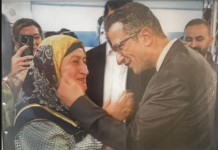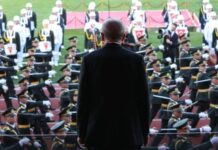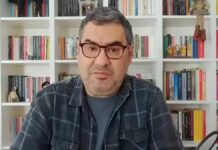In 2002, I moved from the Anatolian side of Istanbul to Dikilitaş, a neighborhood in Beşiktaş situated on a hill that looks toward Nişantaşı. I moved there in order to begin working at a language dersane or special after-hours preparation “school” in Şişli, one of the main business districts in the center of Istanbul that is a fifteen-minute walk from Dikilitaş. For several years I often walked to and from Şişli for work.
As soon as I began walking through Hakkı Yeten Street in Fulya that connects Dikilitaş with Şişli, I noticed a strange türbe (1) on the Nişantaşı side of the avenue. At that time, this türbe was surrounded by a green metal fence, bordered by several trees, and backed by a large, tree-covered slope. It was directly across the street from one of the Beşiktaş sports club’s practice fields (which has since been replaced by high-rise office and residential towers).
On one of my earlier journeys to Şişli I read the sign attached to the metal fence, which explained that the türbe was that of Bardakçı Baba (Father Cupmaker). The sign also explained that no candles should be lit or glasses broken by the saintly person’s türbe because those actions were superstitions; instead a person should simply recite the normal prayers to Allah. Because there are so many türbes in Istanbul I didn’t pay much attention to it, and occasionally I would see someone reciting a prayer next to the tomb. Around the time of the Feast of Sacrifice, the hillside behind the türbe was used as temporary pasture for farm animals, mostly sheep as well as a few cows, brought in by farmers to be sold to monied Istanbuliotes for ritual slaughter.
.jpg)
Later that year, in November, an item appeared in the Turkish daily Milliyet that stunned me. A dentist had come forward to claim that the Bardakçı Baba türbe was a hoax that he and his dentistry school buddies had played on the ignorant neighborhood locals in the late 1960s (2). In the late 1960s, Fulya was not built up, and Marmara University’s Medical School was (and is) just down the road from Bardakçı Baba.
It was while pondering this new bit of information that I realized something which I then never forgot: Only intense fear and hatred of the common people and their culture could drive someone to play such a prank. The depth of the contempt that Turkish elites felt towards the popular masses dawned on me. At that point I had already been in Turkey long enough to notice the class differences in Turkish society, but because I spent most of my time in working-class neighborhoods, I didn’t have a lot of direct contact with upper-class Turkish attitudes. U.S. elites also have fears concerning the masses, but their relationship to religion is often ambiguous. At least it is not a blanket matter of the” enlightened, science-minded” elite versus the “religious, i.e. ignorant and superstitious” people. Though I was raised in a religious family, I don’t have any attachment to religion. I had lived in different areas of the U.S., and encountered various religions as well as attitudes towards religion. But I had never encountered an example of such utter contempt for mass culture and religion.
On top of my initial amazement, in later years I would learn that it was not an accident that a group of medical students should be the culprits for such a prank. From the early 19th century onward, in the Ottoman Empire it was medicine that stood for science, and progress, and the introduction of Western ideas. Conservatives could clamp down on other conduits, but the curriculum of the Askerî Tıbbiye, the military school of medicine, and subsequently of its civilian counterpart, was a “liberated area” because it was so vital to setting up a modern army and state. Hence medical students became exposed to a variety of radical ideas coming from Europe that laid the foundations for the CUP’s revolutionary – authoritarian – modernist ideology. Significantly, the original founders of the group that became the Committee of Union and Progress (CUP) were also students at the same army school of medicine. And Turkish medical faculties have continued as a source of radically Westernizing but anti-democratic ideology ever since.
This example of the Bardakçı Baba türbe has reoccurred to me over the years as I encountered many other examples of the Turkish elites’ self-orientalizing attitudes towards their popular masses. For example, Turkish elites in general display a highly confused approach to language. As foreigners will quickly learn, members of the elite will generally try to force them to speak English even if the foreigner is highly fluent in Turkish. Is this simply in order to demonstrate how Western they themselves are, or does it also have earlier, deeper roots? Personally, I trace this attitude back to the Ottoman period, when for the Ottoman elites the term “Turk” was a derogatory slur (a bit like ceorl/churl or villein/villain) referring to rural peasants; simultaneously, they (the elites) used a Turkish language that was different from the colloquial language used in villages. Only in the last few years of the Empire were Ottoman elites forced to accept that a “Turkish” identity was their most viable choice against the other nationalisms competing for Ottoman territory. Türkiye, which comes from the 12th or 13th century Italian Turchia, was chosen as the new nation’s homeland. But even then, at least part of the 19th century elite prided itself on speaking French and leading a French life-style to underline its alla Franca credentials.
For that reason, the changing of the Turkish script from Arabic to Latin letters, and the subsequent effort in the 1930s to purge the language of “undesirable” Arabic and Persian elements (though it was not, and could not, be totally successful), can be understood not only as an attempt to uproot and transform social memory by disconnecting it from a hated Islamic past, but also as an effort to give that previously despised language of the Anatolian peasantry a more palatable European veneer. But because that condescension towards the Turkish of the masses still exists, and because the Turkish secular elites long ago established their goal as Westernization, Turkish elites attempt to wear their linguistic identities on their sleeves. Possibly the most striking result is the upper- and middle-class Turkish tendency to use English against other Turkish people in order to flaunt cultural and class superiority. To this end, English words and phrases are sprinkled as liberally as possible in daily Turkish conversation. One is constantly reminded of the 19th century Russian aristocracy, which sometimes knew so little Russian (French being that century’s badge of elite socio-cultural status, and not only in the Ottoman Empire) that they could not communicate with their own peasants.
Hasan Bülent Kahraman, too, mentions the symbolic importance of language in the second volume of his study on Turkish socio-political structures. In 1932, the ezan, the Muslim call to prayer was changed by state decree from Arabic to Turkish, and would not be changed back to Arabic until 1950 in the Democrat Party era. Kahraman explains the issue’s importance as follows:
… it can be proposed that the “Turkification/Turkishification” approach would, to a
certain extent, alienate the masses that felt a connection to Islam, and that it was thought that the feeling of a new identity created around symbols would unite them. The call to prayer, one of the most important symbols of identity, was accepted and would be left in place, but it would be transformed (Turkishified). Definitely this would transform the hegemonic and accepted feeling of belonging as well as the perception of identity to an important extent. This [the Turkish call to prayer] can easily be emphasized as one of the most important elements of the favorable stance towards self-orientalization that we previously touched upon. (3)
Another way this self-orientalization manifests itself is through the symbols that Turkish state elites have chosen to represent, and send messages to, the nation. Consider this: When tourists go to London or Athens, they all come back with pictures of the Beefeaters or the Grenadier Guardsmen, or else the Evzones (which represent the Klephts of the Greek War for Independence) at the Greek Parliament building. Even the Vatican in Rome still has its contingent of Swiss pikemen. All of these military remnants are symbols of traditional military and cultural identities, and are regarded as important national icons.




The Turkish equivalent of these national military and political symbols, on the other hand, are the modern Turkish soldiers guarding the Anıtkabir (Atatürk’s mausoleum) in Ankara or Dolmabahçe palace in Istanbul. These soldiers are specifically symbols of the Turkish Republic, and especially their presence at Anıtkabir is intended as a political statement from the Turkish secular elites of the military and bureaucracy. One message sent by the military presence is the modernizing project of the Turkish elites, who not only rejected the Ottoman past, but took a variety of steps to try to erase that past. Like the Jacobins, the Turkish elites attempted to change not only the social system, but to eliminate the cultural and political vestiges of the ancien régime. For that reason there are no Ottoman symbols at Atatürk’s mausoleum, and the mausoleum itself suggests (a mid-20th century Germanic interpretation of) Classical Greek architecture.
.jpg)
One of the statue groups at Anıtkabir makes another symbolic political statement that is of a fully self-orientalizing character. In that group there are three male figures: two in the foreground, gazing confidently forward towards the future, and one in the background, head slightly bowed compared with the others (4). The two in the foreground are dressed respectively as a soldier, meant to represent the Turkish military, and a civilian carrying a book, meant to represent the state bureaucratic elites and the intelligentsia. The figure in the background is dressed as a traditional Anatolian peasant, following and supporting the others. Just to make the point more clear, Anıtkabir was designed to be the national altar, the focus of Turkish national identity, and this group of statues was chosen to send symbolic messages to all those who came to give respects at the final resting place of the national father.

Now that I’ve discussed the manner in which self-orientalization was established as a phenomenon in Turkish society by the early Republic’s state and military elites, I will turn to the broader topic of why especially liberal/progressive U.S. academics, experts, and commentators have so dramatically misread the current socio-political changes happening in Turkey. In the coming weeks, after discussing the manner in which current Turkish events are portrayed in the Western press, I will argue that a basic source of Western misconceptions concerning Turkish politics and society is Bernard Lewis’s The Emergence of Modern Turkey, a text steeped in the Modernist prescriptions of the post-WWII era of American ascendancy. In conjunction, I will try to explain the connection(s) between Lewis’s study and the self-orientalization of the Turkish elites.
NOTES
(1) In Islamic orthodoxy, building tombs or türbes are permitted but visiting them is not, since it is construed as appealing to and asking for the favorable intercession of the dead. Nevertheless, türbes, whether of actual individuals (such as a sultan or grand vizier or the grand admiral Barbarossa), or of popular saints, tend to become important in popular religion, and visiting them is tolerated because of the widespread mass reverence they elicit. Traditionally, people go to famous türbes to pray especially during religious holidays.
(2) http://www.milliyet.com.tr/2002/11/22/yasam/yas01.html
(3) Kahraman, Hasan Bülent. Türk Siyasetinin Yapısal Analizi, Cilt II: 1920-1960 [A Structural Analysis of Turkish Politics], Volume I: 1920-1960 (Istanbul: Agora Kitaplığı, 2010), pp. 277-278. The translation is mine.
The original Turkish text is: … ‘Türkleştirme/Türkçeleştirme’ yaklaşımının İslam’a bağlı kitleleri bir ölçüde yabancılaştıracağı ve semboller üstünden gelişen bir yeni kimlik duygusuyla bütünleştireceğinin varsayıldığı öne sürülebilir. En önemli kimlik sembollerinden birisi (ezan) kabul edilmekte, yerinde bırakılmakta ama dönüştürülmektedir (Türkçe’leştirilmektedir.) Bunun egemen ve geçerli aidiyet duygusunu da kimlik anlayışını da önemli ölçüde dönüştüreceği kesindir. Daha önce değindiğimiz öz-oryantalistleştirmeye dönük muhakemenin en önemli unsurlarından birisinin bu olduğu rahatlıkla vurgulanabilir.
(4) I was alerted to these statues by the cover of the 3rd edition of Eric Jan Zürcher’s Turkey: AModern History.












